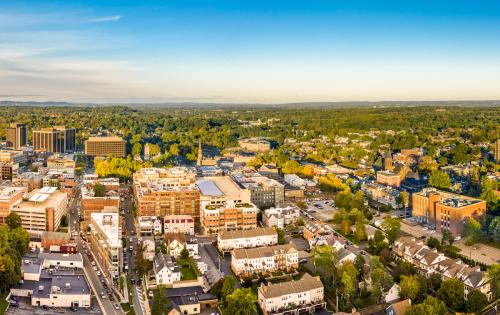Interest in entrepreneurship is on the rise. It is evident in the $100-million pledge that Saudi Arabia and United Arab Emirates recently made to a World Bank fund to assist small business owners, especially women, and in the increase of students in both public high schools and Ivy League colleges studying business skills for future startups. As noted in The Wall Street Journal, even the way television depicts entrepreneurship has changed. Gone are the days of entrepreneurs portrayed as big villains, such as “Citizen Kane,” or down-to-earth working-class heroes, as in “Mystic Pizza,” and instead, the focus is on stories of fictional and non-fictional entrepreneurs who do not just make a living, but obtain great financial wealth, as in the movie “The Social Network.”
Entrepreneurs such as Mark Zuckerberg have become household names and gained celebrity status. And many Americans admired the entrepreneur image of Donald Trump enough to contribute to him being elected president. Ernst & Young and the Economic Innovation Group documented the admiration for startup founders and self-employment among the millennials in a recent nationwide survey: 78 percent of millennials consider entrepreneurs successful and 62 percent of them have considered starting their own business.
Yet, how accurate is this prevailing image of successful and happy individuals who work for themselves? Self-employment is proactive and innovative yet also carries considerable risk. Hypothetically, self-employment should affect happiness or well-being positively, as in the media images. Yet we know little about the actual relationship between entrepreneurship and happiness. In an attempt to answer that question, we analyzed over 600,000 observations from the Gallup Healthways survey for the U.S. for 2010-2016. We compared the happiness levels (across various dimensions) of full-time workers who are self-employed to those who are wage earners (i.e., working for employers). We included controls for a host of potentially confounding factors such as age, gender, education, marital status, race, religion, income, location, and the local unemployment level.
Figure 1: Probable characteristics of a self-employed person
 Source: Gallup. Calculations by authors.
Source: Gallup. Calculations by authors.
Comparison groups: Education: high school degree; Marital status: single; Income: $12,000 to $35,999; Race: white; Religion: Protestant.
As Figure 1 shows, the traits of the self-employed are quite different from their image in the media. They are more likely to have lower levels of education and income than are wage earners, and are more likely to live in areas with high levels of unemployment. This suggests that many of the self-employed individuals opt into entrepreneurship as a default rather than choosing it. Importantly, we find that the self-employed have lower life satisfaction than their wage-earning peers. This contrasts with many prior studies that document a positive relationship between entrepreneurship and life satisfaction. However, it is important to note that we are comparing only those who are self-employed full-time (more than 35 hours per week) with those who are employed full-time, and not to the unemployed, which many studies include. We also use a much larger sample than many earlier studies that focus on the U.S.
There are some nuances. Financially successful entrepreneurs are much happier than those who are not, which is not surprising, and effectively financial success cancels out the negative impact of self-employment. Yet education does not have the same effect. Those who have higher levels of education are not only less likely to be self-employed in the first place (likely as they have other options), but those who are self-employed are less satisfied with their lives. The self-employed who live in areas with lower unemployment rates, meanwhile, are happier. This suggests that these entrepreneurs are more likely to pursue self-employment for fulfillment rather than due to lack of other options.
We also looked at a wide range of emotions that capture the manner in which individuals experience their daily lives—a rough proxy for quality of life. We find an interesting dichotomy: Self-employed individuals are more likely to experience both positive feelings (such as happiness, joy, and future expected life satisfaction) and negative ones (such as sadness, anger, and stress) than their wage-earning peers. The opportunities and constraints/risks facing those who work for and by themselves seem to intensify both types of feelings. Again, it appears that income mitigates the negative feelings associated with entrepreneurship and enhances the positive ones, but education does not.
Overall, our findings suggest that we may have been viewing entrepreneurship through rose tinted glasses. The experiences of many “entrepreneurs” in the U.S. may be closer to the experiences of those working as street vendors in developing economies, rather than to those of technology startups. Our results support the view that there are really two types of entrepreneurship: necessity-based and opportunity-based. Opportunity entrepreneurs are more likely to be highly educated, possess valuable skills, have solid job alternatives, and choose to leave their jobs to exploit opportunities. On the contrary, necessity entrepreneurs generally have low education levels, do not have relevant experience or skills, and often operate in the informal sector without opportunities for upward mobility. They are likely to have become self-employed in response to job loss or lack of stable wage-earning job opportunities.
While the popular view of the self-employed is very much that of the opportunity entrepreneur, the data suggests that many self-employed individuals in the U.S. are self-employed out of necessity due to lack of better alternatives. With the changing nature of the labor market in the U.S. due to various reasons, including the decline of blue collar jobs on the one hand and the rise of the sharing economy and millennials’ preference for flexibility and control on the other, it is important that we do not mix myth with reality.









Commentary
Are the self-employed happy entrepreneurs?
September 29, 2017